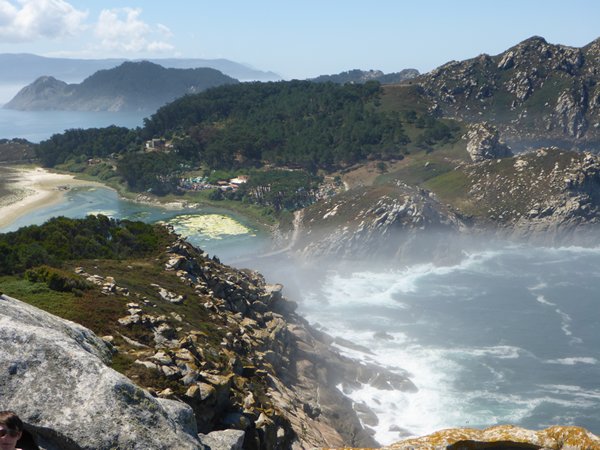23 Jul 2015
43:23.80N 08:48.06W Between Porto Novo and Sanxenxo
For two days we explored the contrasting seaside resorts of Sanxenxo, with its plush hotels and long sandy beach off which we were anchored and Porto Novo, approached along a long wooden board walk and home to a big caravan and campsite. Separating the two towns is a wooded headland with a few walled and gated houses and a lovely wooden bar with verandas on three sides, where we passed a number of hours in quiet contemplation as you can imagine.
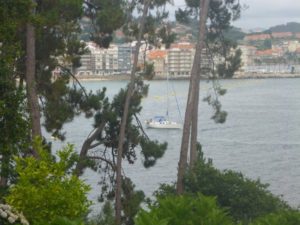
20th July
Another Monbus coachride took us into the main city of Galicia, Pontevedra. We took a taxi to the old town from the coach station and spent a few hours following a pink line showing points of significance on a tourist map provided by a young lady in the Information Office who learned her perfect English in America and London where she was nanny to three badly behaved boys. “My basic English was good but I had to quickly learn the words needed to control those three boys who were constantly fighting!”
The expression on the face of one of the statues of the Virgin Peregrina (Pilgrim Virgin) reminded me of my on line Scrabble teacher’s emoji expression when she feels I could have scored more points than I did. Virgin Peregrina is patron saint of this area which is on the pilgrim route to the Shrine of St James at Santiago de Compostela behind us in Galicia.
At lunch time we sat at a bar around a fountain where pigeons were taking a shower but as no one appeared to be serving we moved on down a stone-walled street and chose two comfortable looking directors chairs next to an ancient wall, green with age and providing wonderful cool shade. Our waiter learned his English while in Florida for a year and served us a tasty lunch of calamari, deep fried green pimientos and bread and then he kindly slipped us a tapas of mussels.
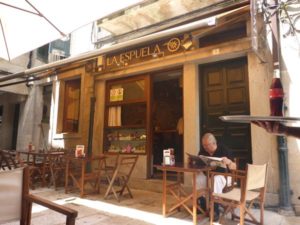
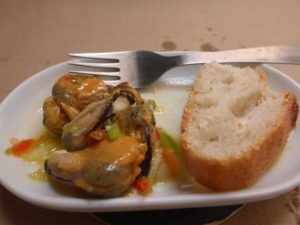
Rolling along the road back to Zoonie we passed the fishing village of Combarro where the horreros in the fishermens’ gardens overlook the viveros just offshore. The former provide winter storage for any food that will keep, like maize, potatoes, garlic, grain and maybe, in this location, salted fish. The horrero is a lovely part of Galician culture, little pantiled ‘houses’ on legs some topped with crosses, a charming pre-refrigeration means of food preservation that is still used today.
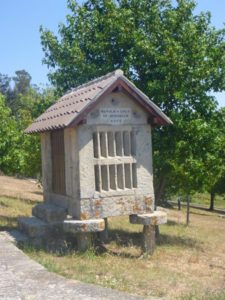
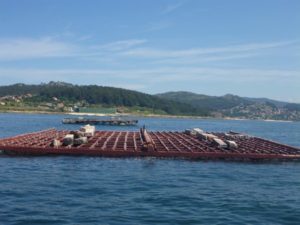
While the tender was in the water we decided to give Zoonie’s hull a scrape off around the waterline. Rob held the dinghy in so I could lean over and with a paintscraper edge flat on the surface I took as much off as I could while happy I was not scratching the coppercoat. After which we decided to take a swim around her a few times.
I could not but admire the slender outward curve of her accommodating hull as I swam slowly around the part of her we rarely see. At the stem, (front pointy vertical part) I swam backwards away from her a few strokes and looked up and down her most forward line, about four inches wide, with numerous repaired dents and scratches, her strong stem that is leading us over the surface of the earth.
We had an excellent spot and could watch events on the beach and in the water; pedallos, boards, dinghies, kite surfers and swimmers all loving life itself. The local Marine Guardia were checking on the papers of the anchored motor boats who were not flying ensigns. We fly our red ensign and a neighbouring French yacht was flying the tricolour so I wonder if that’s why they didn’t bother with us this time.
Such a trouble free, restful place to anchor firmly in sand we were reluctant to leave but on the 21st July we departed as soon as the fog cleared bound for the first of the Galician nature reserve islands we would visit, Isla Ons.
Zoonie was sailing nicely in 6 – 9 knots of wind towards the island when, with an expression of steely determination on his face, Rob appeared with rod in one hand and box of tricks (hooks etc) in the other. Zoonie was sliding quietly along at about 3 knots, perfect mackerel conditions. Within minutes two were on the line but one dropped off. We landed the one fish in the washing up bowl and in quick succession Rob caught another six. So lunch and supper were catered for.
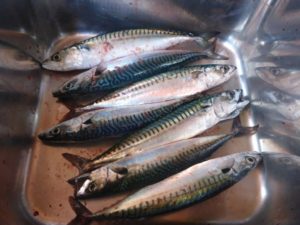
We tried anchoring in weed over sand but Zoonie dragged. Although we could have had another try I spied some blue visitors’ buoys off the mole at Almacen where the visitor boats ply to and fro to the mainland all day and we picked one of those up instead.
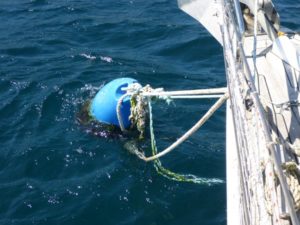
23 Jul 2015 42:22.62N 08:55.77W Isla Ons
All these islands are part of the Marine Nature Reserves of Spain and a permit is required to moor, anchor and go ashore. This we obtained with the help of the Marina lady at Vilagarcia. As yet we have not been asked to show it despite a patrol boat, looking a little like a second world war army tank, passing us when we first arrived.
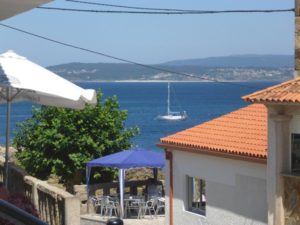
A walk on the fog veiled island revealed well-worn tractor tracks leading to the lighthouse and beaches and passing newly restored cottages, the ones with contentedly clucking hens appeared to be lived in all the time. A restored washing house fed by a stream, groves of oak, chestnut and eucalyptus trees amongst the abundant gorse and bracken added to the charming fragrance and atmosphere.
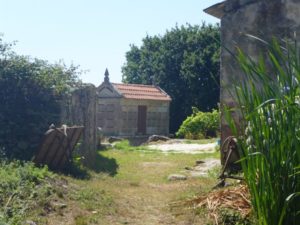
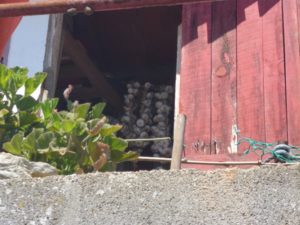
Areas of gorse had been harvested, perhaps to provide fire breaks and the thickest stems of the undergrowth chopped and piled up for winter fuel. The island reminded me of carless Sark as here the small tractor trailer combination is the order of the day.
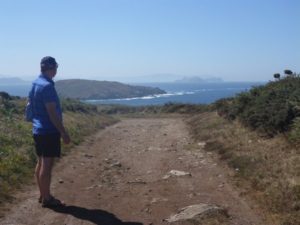
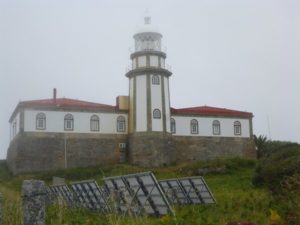
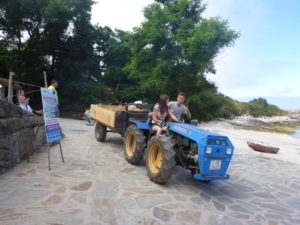
Riding on Rob’s fishing success we had fried mackerel fillets with salad and bread for lunch and rustic mackerel pate with cheese biscuits for supper. And indigestion later that night.
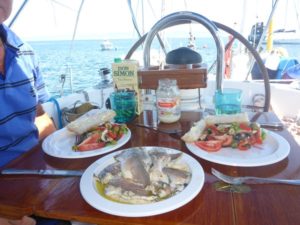
22nd July The Green Walk on Isla Ons.
Like summer days on the Cornish coast, rugged headlands stand proud between lush green sloping valleys. As the cold Atlantic air hits the warm air over the pink granite coast moist fog forms and keeps the islands lush. There is a perfect beach for children just before the hamlet of Almacen. White sand to walk over to the rock pools to lose yourself in another world of sea urchins, tucked harmlessly in clefts, anemones, young green balloons of bladderwrack, determined limpets and little black crabs. There was just a little sandy bay, a few metres wide, where you could swim between the walls of barnacle coated rocks.
Refreshed on pulpo (octopus), green pimientos and chips washed down with beer at one of the bars we rowed back to Zoonie.
Funny how folk can provide entertainment without knowing it. A man in a hard bottomed rib dropped his daughters off on the quay to where his wife and son were waiting and then took the powerful boat with its two outboard engines out to moor it for the night. He took ages to ‘put it to bed’ and in the process had accidentally released the tiny dinghy that would take him back to shore.
“Rob look the dinghy is floating away” I said.
“Well I thought it was on a very long painter, but no you’re right its free”. Seconds later as the man looked around at his handiwork he raised his arms in despair. Off came the covers, on went the engine, he released the mooring line and chased after the dinghy, returned to the mooring and started all over again. In the very last of the daylight we saw him reach the shore and his eagerly waiting family.
28 Jul 2015 15:52:52
42:13.00N 08:54.00W Playa Arenas das Rodas Anchorage off Isla de Cies
Zoonie took us on a very gentle inter island sail south to this world famous beach on Isla Cies (Thies). Rob hooked one fish on the way but it decided it wasn’t ready to be caught.
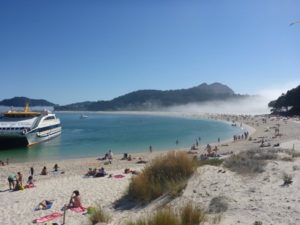
Back in 2007 ‘The Guardian’ newspaper claimed this was the best beach in the world. I wonder if the journalist has visited every beach in the world to make this decision. The beach is lovely but is now SO popular the only time it has that deserted island idyll look is before 10.00 and after 20.30 when the last visitors have left. If the weather is fine the beach is packed.
These islands are part of the Spanish Marine Nature Reserve and in a way it is good that as many people as possible enjoy them. A leading factor that will keep them wild is the lack of cars and metalled roads. I was again reminded of Sark where the only wheel transport is tractors and trailers, although there are a couple of white four by fours here also serving the teenagers campsite. The tracks are wide and well-worn for walking, keeping people on the marked paths and thus maintaining the privacy of the wildlife.
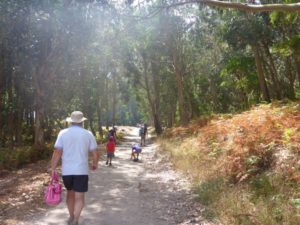
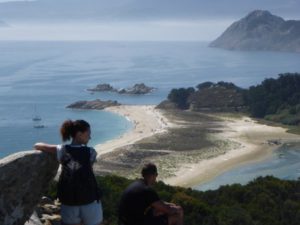
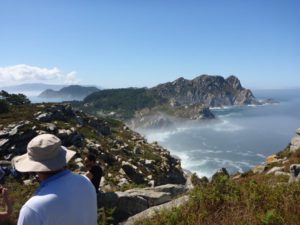
We had a wander over the man-made causeway which provides protection from the sea to a salt-water lagoon full of conger eels, mullet, urchins, octopus, and crab. The harbour mole handles the many arrivals of visitor boats from Vigo, Cangas and Baiona, in fact one company boasts it brings around 1 million visitors a year and places are limited. (The Galapagos of Galicia? I hope they don’t become a victim of their own success.)
At one of the three bars we drank Alhambra Reserve Beer and at 6.4% it was tasty and potent and then we retured to Zoonie for the night.
As we sat in the cockpit enjoying the evening we saw three lads get into their dinghy for a spell ashore leaving behind their vocal dog as dogs are banned from the island. After a while they returned clearly the better lubricated by the Alhambra brew and the next thing we saw was white ‘Montmorency’ the dog barking at them as they jumped naked into the water for a cooling swim. I couldn’t help but think of the literary comparison of Three Men in a Boat, not forgetting the dog (the black dog, Montmorency) by Jerome K Jerome.
But here the comparison must end, for once back on board and preparing for departure, the anchor resting safely back on its roller, one of them came up from below sporting an impressive and ready baby maker to show us! I averted my eyes of course. They were high on the Alhambra and their pretty little yacht took a winding route out from the anchorage.
24th July
In the early hours the wind piped up making the anchorage a noisy place. In fact there is no protection from any direction unless tucked up close to the shore and all those spots were taken by smaller craft. Still we hadn’t come all this way to be defeated so in the cool grey light of day Rob and I cleaned Zoonie as she rock and rolled. I did the windows and mirrors inside and Rob washed the floors.
Then we braved the elements, as the sun was emerging, and in pursuit of our hobby we walked to both lighthouses. Faro de Cies is high up 175 m above sea level. The final climb over a granite stone walled track looks like the Great Wall of China and is only for fairly fit walkers. While lower down, Faro da Porta serves the gap between Isla Cies and Isla San Martino to the south. Both had us admiring the design and building skills of past generations.
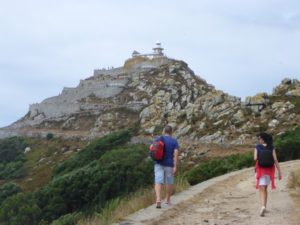
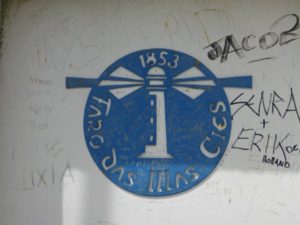
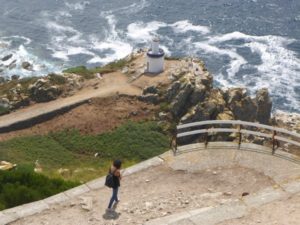
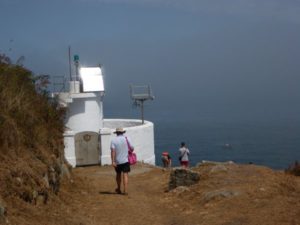
After the rain of the night before, the smell of eucalyptus oil was all pervading and we wandered back past blackthorn bushes covered in sloes and the youth campsite busy with football playing boys and girls. Lunch comprised tasty ‘harvest’ fish and chips and bread at the Alhambra bar.
That night we slept on the settee berths in the saloon away from the drone of the wind generator mast in the continuing strong wind. We hoped to go back ashore in the morning to walk the north end of the island but given the choice of a cosy marina or another risky and wet row ashore we took the former on the basis the islands have been here for millions of years and they’ll be here if and when we next visit.
